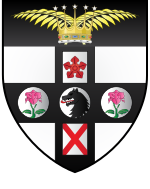Campion Hall
| Campion Hall | |
|---|---|
 |
|

Blazon: Argent on a cross sable a plate charged with a wolf's head erased of the second between in pale two billets of the field that in chief charged with a cinquefoil and that in base with a saltire gules and in fesse as many plates each charged with a campion flower leaved and slipped proper on a chief also of the second two branches of palm in saltire enfiled with a celestial crown or.
|
|
| University | University of Oxford |
| Location | Brewer Street, Oxford |
| Coordinates | 51°44′58″N 1°15′29″W / 51.749582°N 1.258032°WCoordinates: 51°44′58″N 1°15′29″W / 51.749582°N 1.258032°W |
| Established | 1896 |
| Named for | St. Edmund Campion |
| Master | The Revd James Hanvey, S.J. |
| Undergraduates | 1 |
| Postgraduates | 9 |
| Website | www |
| Map | |
Campion Hall is one of the Permanent Private Halls of the University of Oxford in England. It is run by the Society of Jesus and named after St. Edmund Campion, a martyr and Fellow of St John's College, Oxford. The Hall is located on Brewer Street, between Christ Church, Oxford and Pembroke College, Oxford. The buildings, along with many of the fixtures and fittings, were designed by Sir Edwin Lutyens, his only buildings in Oxford. The Hall also houses an extensive and important collection of religious art spanning 600 years; the pieces were collected primarily by Fr. Martin D'Arcy in the 1930s.
The origins of Campion Hall began on 9 September 1896 when Fr. Richard Clarke, who was a former member of St. John's College, Oxford, opened a Private Hall called 'Clarke's Hall'. He was sent by his superiors from the Church of the Immaculate Conception, Farm Street, in London to St. Aloysius Church in Oxford to set up a hall for Jesuit undergraduates. He founded a small house at 40 St Giles', Oxford, and was the first Master of the hall. On 10 September 1896 the hall had its first four students. The hall allowed Jesuits to study for degrees from the University of Oxford.
The rented accommodation that was originally used was too small and 15 months later the hall was moved to Middleton Hall at 11 St. Giles', which was leased to the Society of Jesus until 1936.
In 1900, Fr. Clarke died suddenly at York, and with his death the hall ceased to exist. That year the hall was reopened as 'Pope's Hall' under Fr. O'Fallon Pope as Master, who continued to be Master until 1915. In 1902, he purchased 14 and 15 St Giles', and in 1903 No. 13 St Giles' was also bought.
...
Wikipedia

